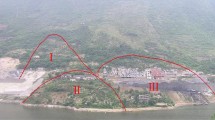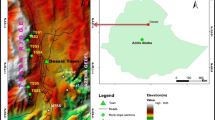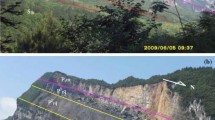Abstract
The B2 talus slide at the Jin’an Bridge hydropower station is located on the left bank of the Jinsha River and very close to the left abutment of the dam. The stability of the dam is directly influenced by the engineering geological properties, formation mechanisms, and failure modes of the B2 talus slide. This paper highlights the investigation and analysis of the in situ engineering geological conditions of the slide area. The results indicate that the B2 talus slide is composed of three parts: the talus deposits consisting of a soil-rock mixture (SRM) in the upper part, unloaded and relaxed rock mass in the middle part, and bedrock with several tuff interlayers in the lower part. Based on topographic and geomorphologic analyses, the structure of the rock and soil, distribution characteristics, formation mechanisms, and influencing factors, the strength of the SRM in the upper part and the properties of the tuff interlayer in the lower part are the main factors affecting the stability of the slide. Additionally, the failure modes of the slide are likely to be circular in nature in the talus deposits, broken line sliding along the interface between the unloaded and relaxed rock and the upper boundary of the tuff and broken line sliding along the tuff interlayer. The strength parameters of the SRM and the tuff interlayer were obtained through laboratory experiments and theoretical inverse analyses. Additionally, a three-dimensional geological model of the slide was created using the aforementioned results and the software GoCAD. Limit equilibrium and finite element methods were used to evaluate the stability of the slide using two-dimensional and three-dimensional models. The results indicate that the slope is stable under natural conditions. However, the slope may be unstable, under special conditions, such as artificial excavation, flood discharge atomization, rainstorms, and earthquakes.
















Similar content being viewed by others
References
Blais-Stevens A, Behnia P, Kremer M, Page A, Kung R, Bonham-Carter GF (2012) Landslide susceptibility mapping of the Sea to Sky transportation corridor, British Columbia, Canada: comparison of two methods. Bull Eng Geol Environ 71:447–466
Discenza ME, Esposito C, Martino S, Petitta M, Prestininzi A, Scarascia Mugnozza G (2011) The gravitational slope deformation of Mt. Rocchetta ridge (central Apennines, Italy): geological-evolutionary model and numerical analysis. Bull Eng Geol Environ 70:559–575
Gu TF, Wang JD, Fu XP, Liu YM (2015) GIS and limit equilibrium in the assessment of regional slope stability and mapping of landslide susceptibility. Bull Eng Geol Environ 74:1105–1115
Hammouri NA, Malkawi AIH, Yamin MMA (2008) Stability analysis of slopes using the finite element method and limiting equilibrium approach. Bull Eng Geol Environ 67(4):471–478
Hearn GJ, Pettifer GS (2016) The role of engineering geology in the route selection, design and construction of a road across the Blue Nile gorge, Ethiopia. Bull Eng Geol Environ 75:163–191
Jiang Q, Qi Z, Wei W, Zhou C (2014) Stability assessment of a high rock slope by strength reduction finite element method. Bull Eng Geol Environ 74(4):1–10
Liu F, Zhao J (2013) Limit analysis of slope stability by rigid finite element method and linear programming considering rotational failure. Int J Geomech 13(6):827–839
Macklin S, Ellison R, Manning J, Farrant A, Lorenti L (2012) Engineering geological characterisation of the Barzaman Formation, with reference to coastal Dubai, UAE. Bull Eng Geol Environ 71:1–19
Medley E (1994) The engineering characterization of mélanges and similar Block-in-Matrix Rocks (Bimrocks). Ph.D. Dissertation, University of California at Berkeley, California, Ann Arbor, MI: UMI, Inc
Medley E, Wakabayashi J (2004) Geological characterization of melanges for practitioners. Felsbau Rock Soil Eng J Eng Geol Geomech Tunn 22(5):10–18
Singh R, Umrao RK, Ansari M, Singh TN (2014) Stability evaluation of road-cut slopes in the Lesser Himalaya of Uttarakhand, India: conventional and numerical approaches. Bull Eng Geol Environ 73:845–857
Sun SR, Xu PL, Wu JM, Wei JH, Fu WG, Liu J, Kanungo DP (2014) Strength parameter identification and application of soil–rock mixture for steep-walled talus slopes in southwestern China. Bull Eng Geol Environ 73:123–140
Tyler SW, Wheatcraft SW (1992) Fractal scaling of soil particle-size distribution analysis and limitations. Soil Sci Soc Am J 56:362–369
Usluogullar OF, Temugan A, Duman ES (2015) Comparison of slope stabilization methods by three-dimensional finite element analysis. Nat Hazards 81(2):1027–1050
Wang ZM, Kwan AKH, Chan CH (1999) Mesoscopic study of concrete I: generation of random aggregate structure and finite element mesh. Comput Struct 70:533–544
Xu WJ, Hu RL (2009) The concept, classification and significance of SRM. Hydrogeol Eng Geol 4:50–56
Xu W, Hu R, Tan R (2007) Some geomechanical properties of soil–rock mixtures in the Hutiao Gorge area, China. Geotechnique 57(3):255–264
Xu WJ, Yue ZQ, Hu RL (2008) Study on the meso-structure and meso-mechanical characteristics of the soil-rock mixture using digital image processing based finite element method. Int J Rock Mech Min Sci 45(5):749–762
Yilmaz I (2009) A case study from Koyulhisar (Sivas-Turkey) for landslide susceptibility mapping by artificial neural networks. Bull Eng Geol Environ 68(3):297–306
Yue ZQ, Morin I (1996) digital image processing for aggregate orientation in asphalt concrete mixtures. Can J Civ Eng 23:479–489
Zhang YS, Guo CB, Qu YX, Song YH (2011) Engineering geological properties of altered rocks and implications for railway construction in the Sanjiang orogenic belt, Southwest China. Bull Eng Geol Environ 70:143–152
Zhou JW, Yang XG, Yang ZH (2015) Determination method for shear strength parameters of rock-soil mixtures using close-range photogrammetry and 3-D limit equilibrium theory. J Mt Sci 12:1068–1083
Acknowledgements
This research is financially supported by the Natural Science Foundation of China (Grant Nos. 41672258, 41102162, and 41472241) and Natural Science Foundation of Jiangsu Province, China (Grant No. BK20141415). The authors gratefully acknowledge Ph.D. Zhigao Dong in School of Earth Sciences and Engineering, Hohai University, China, for his contribution to the field investigation. The authors would also like to acknowledge the editors and reviewers of this paper for their very helpful comments and valuable remarks.
Author information
Authors and Affiliations
Corresponding author
Rights and permissions
About this article
Cite this article
Liu, J., Wei, J., Hu, H. et al. Research on the engineering geological conditions and stability evaluation of the B2 talus slide at the Jin’an Bridge hydropower station, China. Bull Eng Geol Environ 77, 105–125 (2018). https://doi.org/10.1007/s10064-017-1005-8
Received:
Accepted:
Published:
Issue Date:
DOI: https://doi.org/10.1007/s10064-017-1005-8




